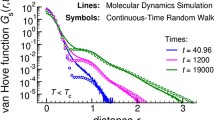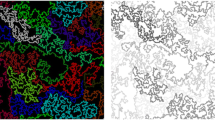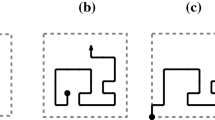Abstract
The density crossover scaling of various thermodynamic properties of solutions and melts of self-avoiding and highly flexible polymer chains without chain intersections confined to strictly two dimensions is investigated by means of molecular dynamics and Monte Carlo simulations of a standard coarse-grained bead-spring model. In the semidilute regime we confirm over an order of magnitude of the monomer density ρ the expected power law scaling for the interaction energy between different chains e int ∼ ρ 21/8, the total pressure P ∼ ρ 3 and the dimensionless compressibility gT = lim q→0 S(q) ∼ 1/ρ 2. Various elastic contributions associated to the affine and non-affine response to an infinitesimal strain are analyzed as functions of density and sampling time. We show how the size ξ(ρ) of the semidilute blob may be determined experimentally from the total monomer structure factor S(q) characterizing the compressibility of the solution at a given wave vector q . We comment briefly on finite persistence length effects.

Similar content being viewed by others
References
R. Jones, S. Kumar, D. Ho, R. Briber, T. Russel, Nature 400, 146 (1999).
S. Granick, S. Kumar, E. Amis et al., J. Polym. Sci. B 41, 2755 (2003).
P. O'Connell, G. McKenna, Science 307, 1760 (2005).
P.G. de Gennes, Scaling Concepts in Polymer Physics (Cornell University Press, Ithaca, New York, 1979).
B. Duplantier, J. Stat. Phys. 54, 581 (1989).
A.N. Semenov, A. Johner, Eur. Phys. J. E 12, 469 (2003).
I. Carmesin, K. Kremer, J. Phys. (Paris) 51, 915 (1990).
P.H. Nelson, T.A. Hatton, G. Rutledge, J. Chem. Phys. 107, 1269 (1997).
A. Yethiraj, Macromolecules 36, 5854 (2003).
A. Cavallo, M. Müller, K. Binder, Europhys. Lett. 61, 214 (2003).
A. Cavallo, M. Müller, K. Binder, J. Phys. Chem. B 109, 6544 (2005).
H. Meyer, T. Kreer, M. Aichele, A. Cavallo, A. Johner, J. Baschnagel, J.P. Wittmer, Phys. Rev. E 79, 050802(R) (2009).
H. Meyer, J.P. Wittmer, T. Kreer, A. Johner, J. Baschnagel, J. Chem. Phys. 132, 184904 (2010).
H. Meyer, N. Schulmann, J.E. Zabel, J.P. Wittmer, Comput. Phys. Commun. 182, 1949 (2011).
N. Schulmann, H. Meyer, J.P. Wittmer, A. Johner, J. Baschnagel, Macromolecules 45, 1646 (2012).
J.P. Wittmer, H. Meyer, A. Johner, T. Kreer, J. Baschnagel, Phys. Rev. Lett. 105, 037802 (2010).
B. Maier, J.O. Rädler, Macromolecules 33, 7185 (2000).
G.T. Gavranovic, J.M. Deutsch, G.G. Fuller, Macromolecules 38, 6672 (2005).
F. Sun, A. Dobrynin, D. Shirvanyants, H. Lee, K. Matyjaszewski, G. Rubinstein, M. Rubinstein, S. Sheiko, Phys. Rev. Lett. 99, 137801 (2007).
F. Monroy, F. Ortega, R.G. Rubio, H. Ritacco, D. Langevin, Phys. Rev. Lett. 95, 056103 (2005).
F. Monroy, F. Ortega, R.G. Rubio, M.G. Velarde, Adv. Colloid Interface Sci. 134-135, 175 (2007).
A. Maestro, H.M. Hilles, F. Ortega, R.G. Rubio, D. Langevin, F. Monroy, Soft Matter 6, 4407 (2010).
L.R. Arriaga, F. Monroy, D. Langevin, Soft Matter 7, 7754 (2011).
K. Sugihara, J. Kumaki, J. Phys. Chem. B 116, 6561 (2012).
If we compute a quantity exactly, including all numerical coefficients, we use an equal sign, i.e., we write A = B. If we state only a scaling law, ignoring all numerical coefficients, but keeping all dimensional factors, we use the symbol ≈ as, e.g., for the chain size in the compact limit, eq. (1). If we want to stress only the power law involved, we use the symbol ∼ as, e.g., for the scaling of the chain perimeter L with chain length N indicated in eq. (2). The dilute limit of a property considered is often characterized by an index 0, e.g., ν 0 = 3/4 denotes the Flory chain size exponent for dilute chains.
J. Wittmer, A. Cavallo, H. Xu, J. Zabel, P. Polińska, N. Schulmann, H. Meyer, J. Farago, A. Johner, S. Obukhov, J. Baschnagel, J. Stat. Phys. 145, 1017 (2011).
L.D. Landau, E.M. Lifshitz, Theory of Elasticity (Pergamon Press, 1959).
J.S. Rowlinson, Liquids and Liquid Mixtures (Butterworths Scientific Publications, London, 1959).
J. Hansen, I. McDonald, Theory of Simple Liquids (Academic Press, New York, 1986).
J.F. Lutsko, J. Appl. Phys. 65, 2991 (1989).
J.P. Wittmer, A. Tanguy, J.-L. Barrat, L. Lewis, Europhys. Lett. 57, 423 (2002).
B. Schnell, H. Meyer, C. Fond, J. Wittmer, J. Baschnagel, Eur. Phys. J. E 34, 97 (2011).
H. Xu, J. Wittmer, P. Polińska, J. Baschnagel, submitted.
J. Baschnagel, J.P. Wittmer, H. Meyer, in Computational Soft Matter: From Synthetic Polymers to Proteins, Vol. 23, edited by N. Attig (NIC Series, Jülich, 2004) pp. 83--140.
G.S. Grest, K. Kremer, Phys. Rev. A 33, 3628 (1986).
S.J. Plimpton, J. Comput. Phys. 117, 1 (1995).
M. Allen, D. Tildesley, Computer Simulation of Liquids (Oxford University Press, Oxford, 1994).
D. Frenkel, B. Smit, Understanding Molecular Simulation -- From Algorithms to Applications, 2nd edition (Academic Press, San Diego, 2002).
Being truncated and shifted at the minimum of the full LJ potential our excluded-volume potential is continuous and differentiable everywhere. As shown in ref. paptrunc, this is of relevance for calculations of elastic moduli using a stress fluctuation relation, such as eq. (eq_KRowlinson), which involves derivatives of the interaction potentials.
This clearly separates the bonded and non-bonded interactions which is of importance for the various thermodynamic contributions investigated in sect. sec_res. Note that some implementations of the KG model, as the recent version of the LAMMPS code, allow to view the LJ interactions between bonded monomers as intrachain contributions.
The bond potential being harmonic, various conformational and thermodynamic properties can easily be calculated if the non-bonded potential is thought to be switched off or known to be irrelevant. Under this assumption the equipartition theorem [37] tells us, e.g., that the average bonding energy e b per bond should be k B T/2. As a consequence the relative deviation from the reference distance l b = 0.967 is given by \(\left\langle {\left( {r/l_b - 1} \right)^2 } \right\rangle ^{1/2} = \sqrt {{{k_B T} \mathord{\left/ {\vphantom {{k_B T} {k_b l_b^2 }}} \right. \kern-\nulldelimiterspace} {k_b l_b^2 }}} \approx 0.0398\). This gives an excellent approximation for the data in the dilute and semidilute regimes where 〈|r|〉 ≈ 0.9692 and l ≡ 〈r 2〉 ≈ 0.9700 (table 1).
The reported MD data have been sampled over a period of about five years using different local and national computational resources which are difficult to compare. The configurations obtained in this limit have been already used and characterized in various previous publications [12-16]. The production of the MC data for smaller densities (ρ ≤ 0.25) performed to crosscheck and improve the MD simulations was much less expensive corresponding to production runs over a year using 8 cores of Intel Xeon E5410 processors.
A. Kopf, B. Dünweg, W. Paul, J. Chem. Phys. 107, 6945 (1997).
For non-interacting phantom chains we have k B T for the pressure contribution per bond as one confirms by integration by parts of \(\smallint drru'_b (r)e^{ - \beta u_b (r)}\). Summing over all bonds we thus have P b β/ρ = −(N − 1)/N = −1 + 1/N and, hence, P = P id + P b = k B Tρ/N.
Plotting P int β/ρ as a function of chain length N reveals the same power law exponents −νθ = −19/16 and 3/8 for the dilute and dense limits as seen in fig. 5 for interchain interaction energy e int(N).
Since the non-bonded interactions get more important at higher densities, these numerical problems become irrelevant for ρ ≥ 0.25. The data points given in fig. 6 and the main panel of fig. 7 all refer to the best δt-independent thermodynamic relevant values available.
This scaling has been directly tested by tracing N Pβ/ρ as a function of x = ρ/ρ * ∼ ρN 1/2>. This plot is not presented since the related dilute-semidilute crossover scaling for the compressibility is given in the inset of fig. 8.
We have additionally checked that similar values are obtained from the volume fluctuations δV in an isobaric ensemble with imposed pressure P using K = k B T〈V〉/〈δ 2 V〉 [37]. While we find again that this method is straight- forward for polymer melts (ρ > 0.5), K(t) is seen to converge increasingly slowly with decreasing density to the asymptotic long-time plateau —just as the compression moduli computed using the stress fluctuation formula, eq. (16), for the canonical ensemble presented in fig. 11.
The presented numerical results suggest to express quite generally the difference η B − η Fof the different potential contributions in terms of the “distinct stress fluctuation correlation” \(\eta _{F,dist} \equiv \frac{\beta } {{d^2 V}}\sum\limits_{l \ne l'} {\left\langle {w(r_l )w(r_{l'} )} \right\rangle .}\) (This can be readily done by integration by parts.) Unfortunately, this expression is quadratic with respect to the total particle number and the direct computation of η F,dist is, hence, not a practical route either.
A similar deviation of the RPA formula in the crossover regime at q ≈ 2π/ξ has also been seen for three-dimensional bulks [51].
M. Müller, K. Binder, L. Schäfer, Macromolecules 33, 4568 (2000).
M. Dijkstra, D. Frenkel, Phys. Rev. B 50, 349 (1994).
F. Birch, J. App. Phys. 9, 279 (1938).
D.C. Wallace, in Solid State Physics: Advances in Research and Applications, Vol. 25, edited by H. Ehrenreich, F. Seitz, D. Turnbull (Academic Press, New York and London, 1970) p. 300.
Author information
Authors and Affiliations
Corresponding author
Rights and permissions
About this article
Cite this article
Schulmann, N., Xu, H., Meyer, H. et al. Strictly two-dimensional self-avoiding walks: Thermodynamic properties revisited. Eur. Phys. J. E 35, 93 (2012). https://doi.org/10.1140/epje/i2012-12093-x
Received:
Revised:
Accepted:
Published:
DOI: https://doi.org/10.1140/epje/i2012-12093-x




